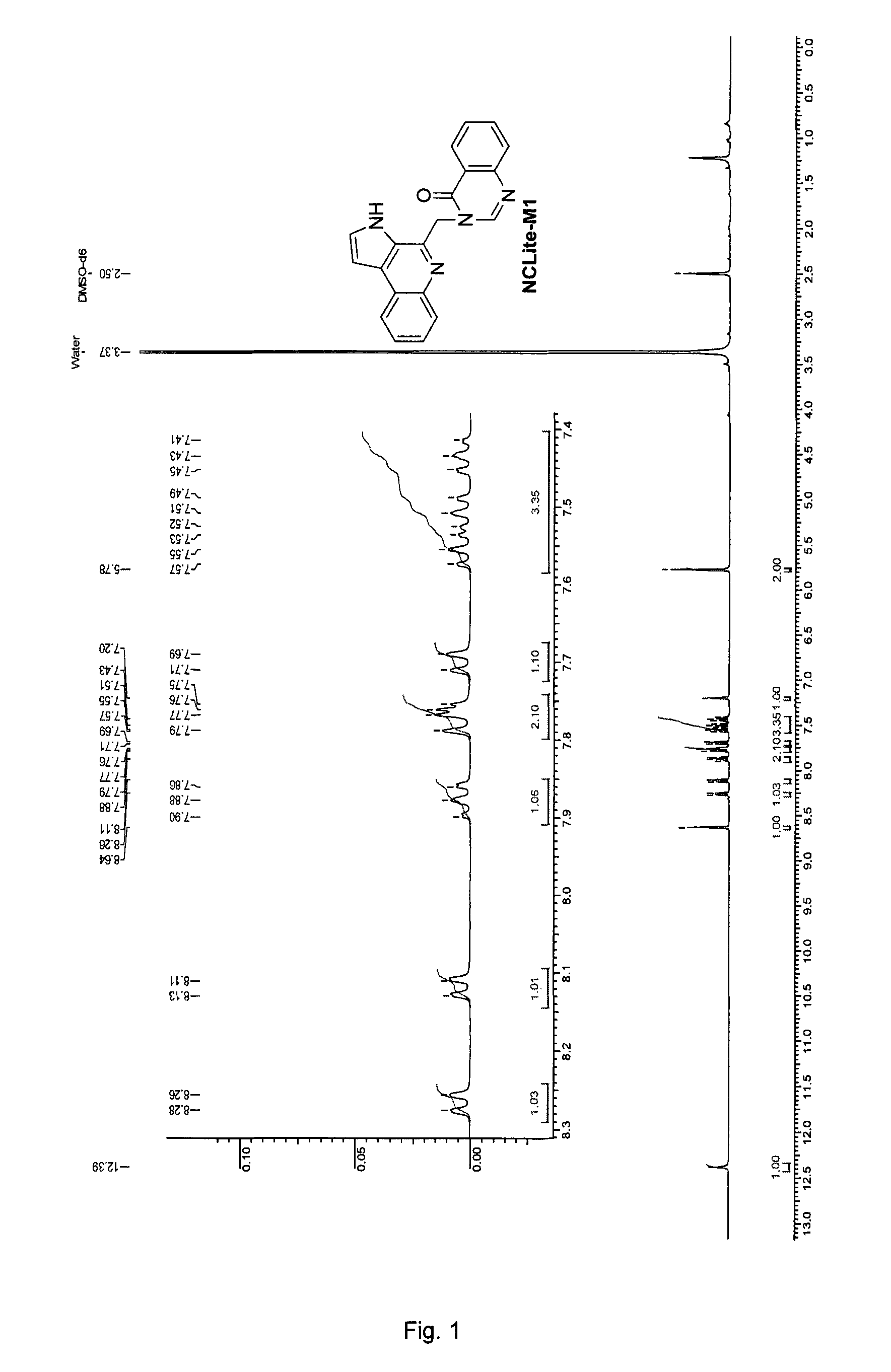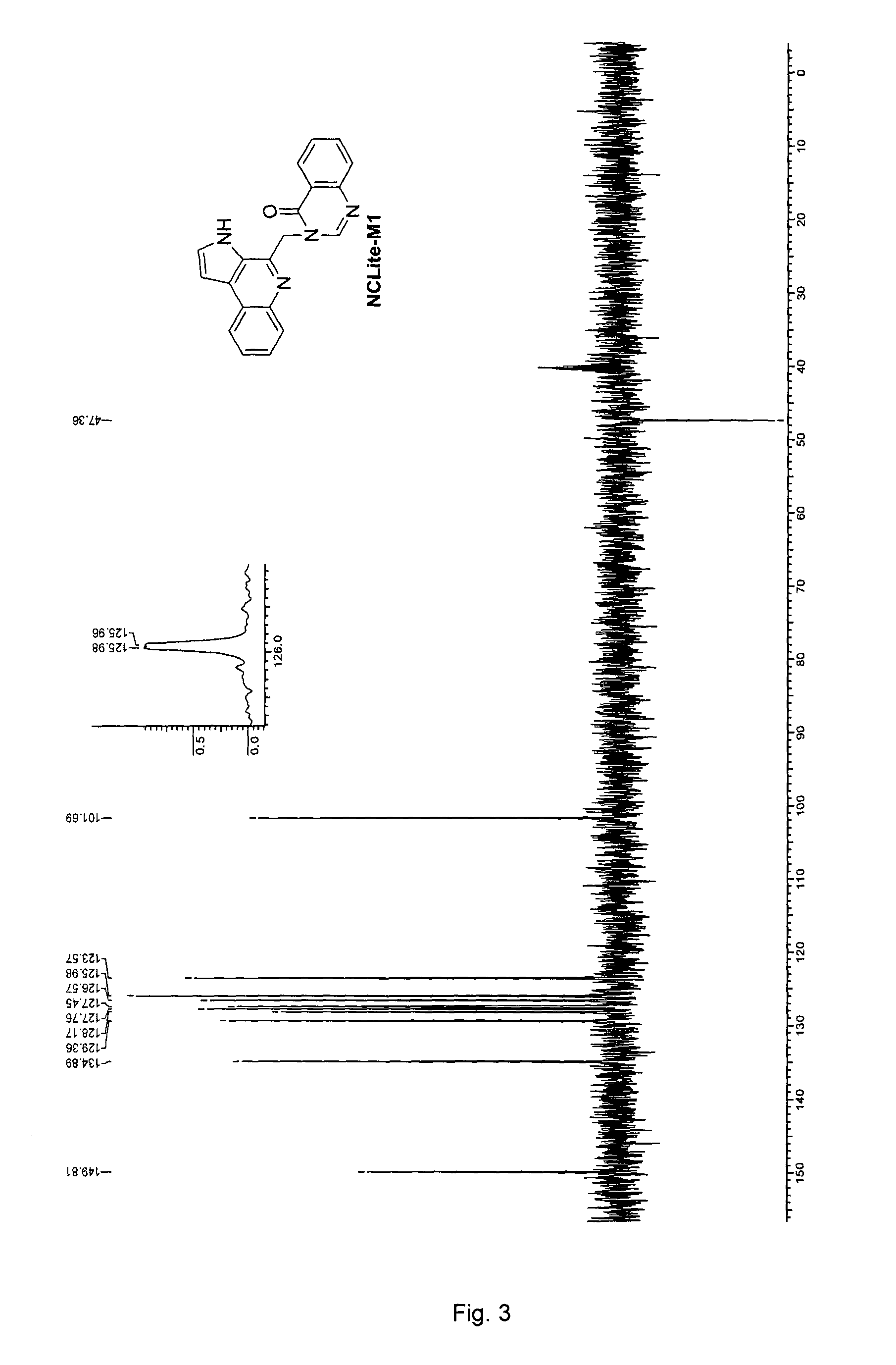Pyrroloquinoline alkaloids as antimalarial agents and process for the preparation thereof
a technology of pyrroloquinoline and alkaloids, applied in the field of new compounds of the pyrroloquinoline alkaloids group and process, can solve the problems of low yield, long synthesis time, and laborious methods available for the synthesis of substituted pyridine based alkaloids
- Summary
- Abstract
- Description
- Claims
- Application Information
AI Technical Summary
Benefits of technology
Problems solved by technology
Method used
Image
Examples
example 1
1-(1-(methylsulfonyl)-1H-pyrrol-2-yl)ethanone (1)
[0107]
Procedure:
[0108]To a solution of acetic anhydride (1.3 mL, 0.13 mmol) in 5 mL of 1,2-dichloroethane at 25° C. was added BF3—OEt2 (3.4 mL, 0.27 mmol). The mixture was stirred for 10 min, a solution of methylsulfonyl protected pyrrole (500 mg, 0.61 mmol) in 2 mL of 1,2-dichloroethane was added, and the mixture was stirred at 25° C. for 90 min. The reaction was quenched with cold water, and the reaction products were extracted into dichloromethane. The residue remaining after concentration at reduced pressure was chromatographed in a column of silica gel (70-230 mesh), eluting with ethyl acetate-petroleum ether (1:9) to afford 1-(1-(methylsulfonyl)-1H-pyrrol-2-yl)ethanone (440 mg, 68%).
[0109]Rf=0.50 (4:1 PE:EtOAc); MP 62-64° C.; IR(Nujol): νmax 2925, 2854, 1711, 1679, 1539, 1459, 1375, 938, 847, 768 cm−1; 1H NMR (500 MHz, CDCl3): δ 2.49 (s, 3H), 3.72 (s, 3H), 6.28 (t, J=3.7 Hz, 1H), 7.11 (dd, J=1.7, 3.7 Hz, 1H), 7.56 (dd, J=1.8, 3....
example 2
2-Iodo-N-(1-(1-(phenylsulfonyl)-1H-pyrrol-2-yl)ethylidene) aniline (2)
Procedure:
[0110]To a dry two
[0111]
neck round bottom flask, equipped with Dean-Stark apparatus, containing freshly activated 4 Å molecular sieves, ketone 1 (100 mg, 0.40 mmol), Iodoaniline (439 mg, 2.00 mmol) and p-toluenesulphonic acid (8 mg, 0.04 mmol), was added dry toluene under argon atmosphere and the reaction mixture was refluxed for 18 h. It was then cooled to room temperature and filtered. The filtrate was evaporated under reduced pressure. Ethyl acetate was added and the organic layer was washed with saturated sodium bicarbonate solution, brine and dried over sodium sulphate. Evaporation of ethyl acetate followed by silica gel chromatography (49:1 PE:EtOAc) furnished 2 as yellow solid (145 mg, 80%).
[0112]Rf=0.50 (19:1 PE:EtOAc); MP 145-147° C.; IR(Nujol): νmax 2928, 2851, 1456, 1374, 721 cm−1; 1H NMR (400 MHz, Acetone-D6): δ2.03 (s, 3H), 6.49 (t, J=3.1 Hz, 1H), 6.70 (dd, J=1.5, 7.8 Hz, 1H), 6.85 (ddd, J=1...
example 4
Marinoquinoline A
[0117]
Procedure:
[0118]To the solution of 3 (50 mg, 0.15 mmol) in MeOH (2 ml) was added K2CO3 (42 mg, 0.31 mmol). The reaction mixture was refluxed for 1 h. Then it was quenched with water and extracted with ethyl acetate. The organic layer was washed with brine and dried over sodium sulphate. After evaporation of the solvent, the crude product was purified by using silica gel column chromatography (1:1 PE:EtOAc) to obtain Marinoquinoline A as a white solid (27 mg, 96%).
[0119]Rf=0.30 (1:1 PE:EtOAc); MP 237-239° C.; IR(Nujol): νmax 3379, 2917, 2857, 1465, 1451, 1377, 751 cm−1; 1H NMR (500 MHz, Acetone-D6): δ 2.87 (s, 3H), 7.15 (d, J=2.8 Hz, 1H), 7.50-7.57 (m, 2H), 7.62 (d, J=2.7 Hz, 1H), 8.05 (dd, J=2.1, 7.3 Hz 1H), 8.25 (dd, J=2.1, 7.3 Hz, 1H), 11.29 (br s, 1H); 13C NMR (125 MHz, Acetone-D6): δ 21.0, 101.9, 123.7, 124.1, 125.7, 126.1, 127.4, 128.5, 129.5, 129.7, 143.3, 146.8; HRMS-ESI (m / z): calcd for [C12H10N2+H]+, 183.0917. found 183.0914.
PUM
| Property | Measurement | Unit |
|---|---|---|
| mol % | aaaaa | aaaaa |
| mol % | aaaaa | aaaaa |
| temperature | aaaaa | aaaaa |
Abstract
Description
Claims
Application Information
 Login to View More
Login to View More - R&D
- Intellectual Property
- Life Sciences
- Materials
- Tech Scout
- Unparalleled Data Quality
- Higher Quality Content
- 60% Fewer Hallucinations
Browse by: Latest US Patents, China's latest patents, Technical Efficacy Thesaurus, Application Domain, Technology Topic, Popular Technical Reports.
© 2025 PatSnap. All rights reserved.Legal|Privacy policy|Modern Slavery Act Transparency Statement|Sitemap|About US| Contact US: help@patsnap.com



